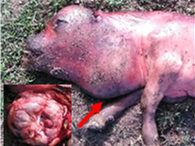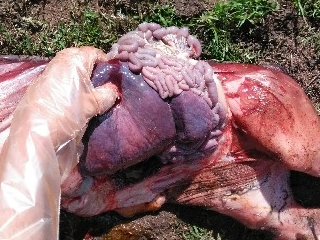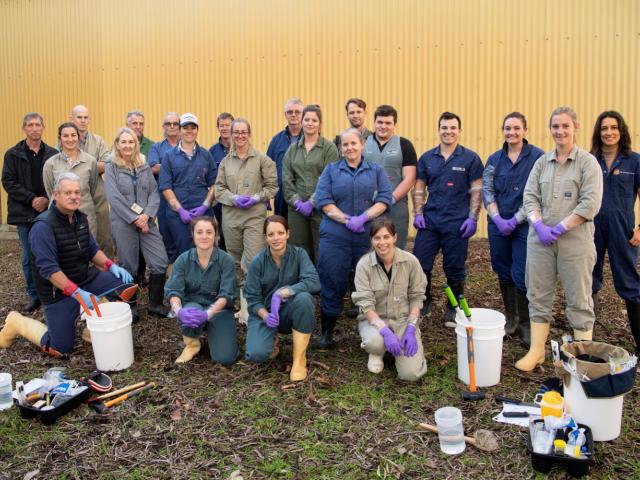| The WA Livestock Disease Outlook provides information about recent livestock disease cases in Western Australia and diseases likely to occur in the next month. Calling a vet to investigate diseases when they occur provides surveillance evidence to our markets that we are free of reportable and trade-sensitive diseases. |
Recent livestock disease cases in WA
Abortions and enlarged necks in red Angus cross calves
- Four abortions occurred over one month in a herd of 80 five-year-old cows in the Wheatbelt.
- One cow had a retained placenta and diarrhoea, but the other cows did not appear sick. Two of the aborted calves had unusually enlarged throats.
- The herd was grazing sorghum and had been fed cabbage.
- On post-mortem of one calf, the head looked misshapen and the heart, liver and kidneys were larger than normal. A melon-sized, purplish mass had caused the throat to appear enlarged.
- Lab testing showed the enlarged throat was due to a thyroid growth (goitre) and the liver was severely congested with blood.
- The cause of death was most likely glucosinolate toxicity given the dietary history and lab findings.
- Glucosinolates are compounds found in brassicas (e.g. cabbages, turnips and Brussels sprouts). Prolonged or overfeeding of brassicas to ruminants can cause thyroid dysfunction, which may result in abortions, stillbirths and weak calves.
Recommendations to producer:
- Remove cabbage from the herd’s diet.
- Iodine deficiency is another potential cause of goitre. Discuss with your vet if iodine supplementation is recommended.
- Feeding sorghum also has the potential to cause toxicity in stock if the quality and feeding regime are not well managed. Hungry stock should not be put onto a sorghum-only diet and should be monitored for 48 hours after being introduced onto sorghum to ensure toxicity does not develop.
- The cows were tested for exotic diseases, including Brucella abortus, with negative results. B. abortus is an emergency animal disease present in cattle in other countries that causes significant numbers of abortions and infertility and is zoonotic. Livestock handlers (especially if pregnant or immunocompromised) should use appropriate personal protective equipment when handling aborted animals or tissues to protect themselves from potential zoonotic diseases.
- Always report livestock abortions to a vet so that they can investigate to find the cause and rule out exotic diseases via lab testing. Testing to show that we are free of these diseases supports our livestock markets.
- Read more on bovine brucellosis.
Severe neurological signs in heifers in the South-West
- Two heifers, introduced to a herd of 20 in late 2017, died within a three-month period, after having shown severe neurological signs of staggering, muscle tremors and seizures.
- One heifer was found lying on its side with muscle tremors affecting the head and body and no blink reflex.
- Post-mortem of this heifer found mild inflammation of the first and fourth stomach with nodules in the lining of the fourth stomach.
- Lab tests showed extensive brain disease (cerebrocortical necrosis or polioencephalomalacia) and a severe thiamine deficiency. Tests for lead and annual ryegrass toxicity were negative.
- The herd was being fed hay and kikuyu/rye pasture, but had been moved off hay at the break in season. A decrease in roughage or a sudden increase in carbohydrates (e.g. grains) is a common cause of thiamine deficiency, which can lead to brain degeneration and result in neurological signs.
- Cases are often sporadic, but can occur in up to 10% of the herd.
Recommendations to producer:
- Test a proportion of the herd for thiamine levels and supplement with thiamine to prevent further losses. Early treatment can result in improvement although neurological signs may persist if disease is advanced.
- Neurological signs in adult cattle could be a sign of a transmissible spongiform encephalopathy (TSE – mad cow disease), a disease exotic to Australia. Subsidised testing for neurological disease in cattle in the correct age range is recommended as it helps us to prove that Australia is free of TSE. For more information, visit the NTSESP webpage or speak to your vet.
In spring, watch for these livestock diseases:
| Disease, typical history and signs |
|---|
Coccidiosis in young stock
Recommendations:
|
Cobalt/vitamin B12 deficiency
Recommendations:
|
Vets sharpen disease investigation skills at private vet workshops
More than 40 Western Australian veterinarians gathered in South Perth recently to attend practical workshops to sharpen their skills in livestock disease investigations. The workshops covered every aspect of a disease investigation from knife-sharpening to brain removal as well as tips for obtaining a history and samples that will maximise the likelihood of a diagnosis while protecting the biosecurity and health of all involved in the process.
Read more on the workshops in the quarterly Fit to Trade e-bulletin as well as on other livestock biosecurity topics, including how WA is benefitting from a program to train WA vets and industry to identify signs of foot-and-mouth disease and the latest updates on footrot and livestock traceability.



